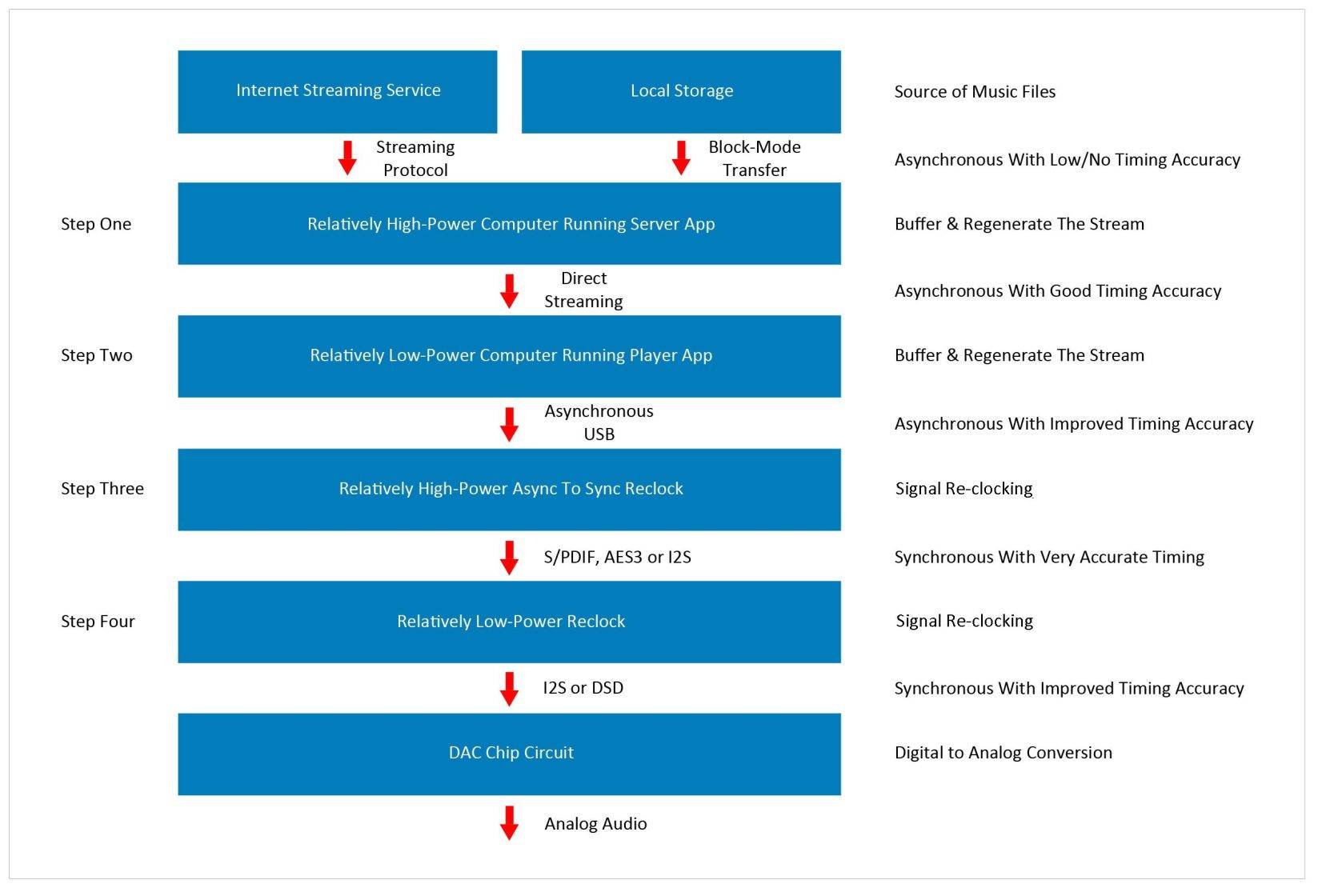Design Philosophy

The science of digital audio makes things sound simple. In practice, the processes require high levels of processing power and wide bandwidth, at the same time as keeping noise interference very low. These requirements work against each other. For example, higher power generates higher noise levels, and filtering noise limits bandwidth.
Antipodes minimises the trade-offs between clocking, noise and bandwidth by:
- designing its circuits from the bottom-up for low noise, which reduces the need for noise filters
- designing very fast low-noise power supplies to support the bandwidth requirements
- designing around optimisation of a four step process.
In our four-step approach (see the diagram below), the first two steps use asynchronous streaming, buffering and regeneration of the stream. Step 1 uses high processing power and Step 2 repeats the process with low processing power. The key objectives are to achieve low noise and high bandwidth. Because the first two steps use asynchronous transmission, a very high-precision clock at the sending end is not warranted. For example, in asynchronous transmission, the receiving electronics will command the sending electronics to slow down or speed up to make sure the buffer does not empty-out or over-flow.
The last two steps use synchronous signal transmission, re-clocking the signal with reference to an ultra-high-quality clock. Step 3 re-clocks using high processing power and Step 4 repeats the process with low processing power. The high-power Step 3 also has to convert the asynchronous signal to a synchronous signal. In the last two steps, transmission is synchronous and so the key objectives are precise signal clocking, low noise, and high bandwidth. This is where using an oven controlled circuit and ultra-low phase error clocks are crucial but, as is always the case in digital audio, the power supply has a huge influence on the final result.
Note that the fourth step occurs in the DAC where it is almost always a low-power processing step. Preceding it with a high-power re-clocking step will lift the performance of any DAC.

The need for precise clocking appears to be well recognised, and many discussions focus heavily on the clock used, but the effect of the clock on timing is only as good as the combined weaknesses of the clock, the re-clocking circuit, the circuit layout, the other electrical parts, and the power supply. The power supply has a huge impact on all digital circuits, because it is a major challenge for a power supply to deliver the required speed for high-power high-bandwidth processing, at the same time as keeping noise very low.
It is sometimes claimed by DAC manufacturers that their DAC completely eliminates timing errors. But, by way of example, an APLL (which is often used for re-clocking) is similar to a negative feedback system. The timing in the signal received is compared to a reference clock to determine the timing error in the signal. The error is inverted and added to the original signal in an attempt to correct the timing error. Just as using negative-feedback does not make amplifiers perfect, real-world challenges mean that APLLs, ADPLLs, etc, vary in quality and none ever deliver a perfect result. Some re-clocking techniques are much more sophisticated, but the point remains that perfection is never attainable. Feeding the DAC with a better signal from the Music Server/Player always improves the sound quality.
The four step process is designed to improve timing accuracy at each of the successive steps. As an analogy, imagine your car is caked with mud and grime. You might take four steps to get it very clean.
- Water-blast off the big pieces of dirt.
- Use a sponge and warm soapy water to clean it further.
- Rinse with fresh water and towel it dry.
- Apply wax, and polish.
If you skip any step, you compromise the end result. Similarly, if you improve the quality of any one of the steps, it is very likely that you will improve the end result. And this is true too of the four step digital audio playback process we have described above.
In digital audio, even more steps may improve the timing further. For example, there are several products that are claimed to improve timing at various points in the process, such as network switches, network bridges, signal regenerators, etc. We have found that the money is better spent on improving the quality of the four steps outlined above, rather than adding more steps. So we recommend you look to buy a better music server/player than buy a less capable one together with these add-on products. But you can use these add-on products to improve the performance of a music server you have already invested in, provided you select them well. Beware that in the wrong context, many of these add-on products can reduce performance.












